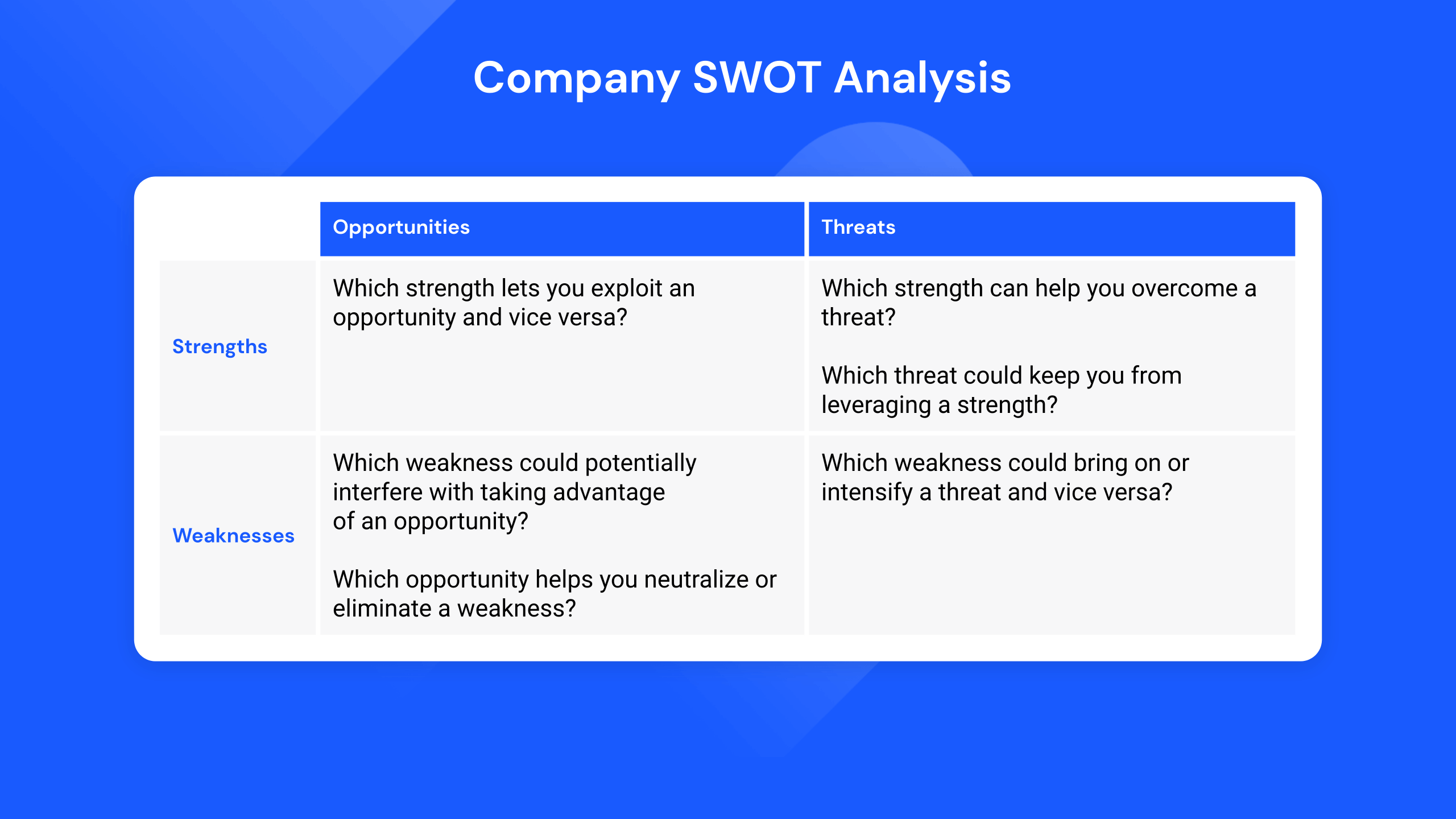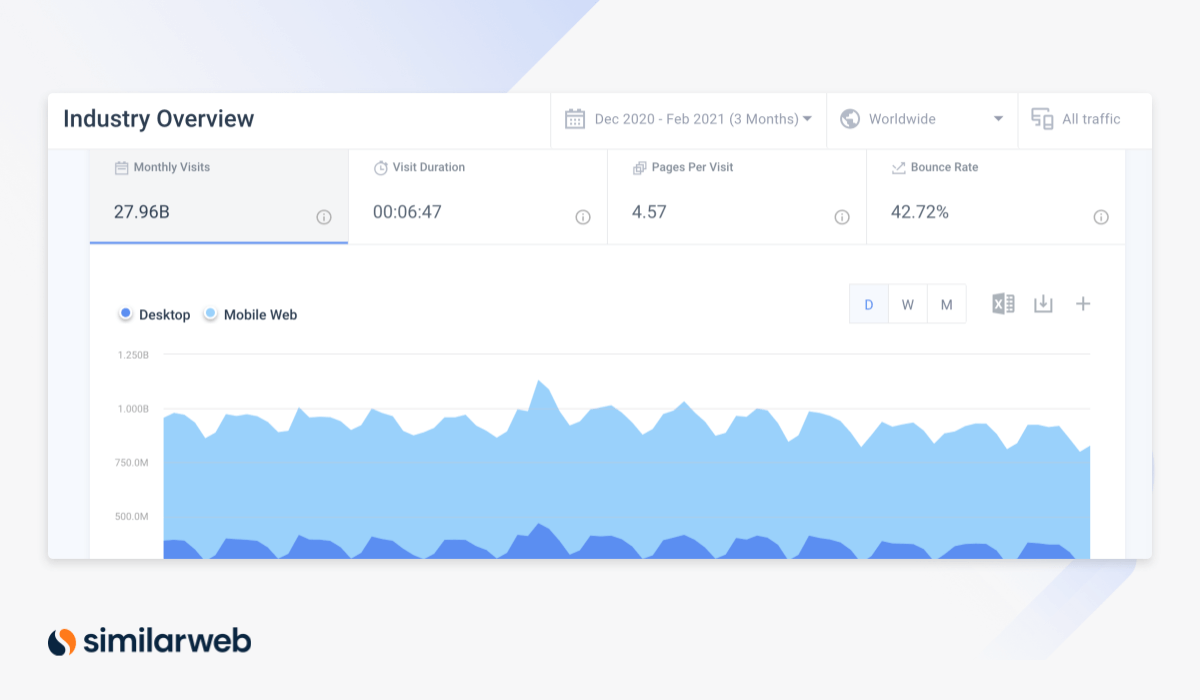Your Guide to Effective SWOT Analysis [+Free Template]
![Your Guide to Effective SWOT Analysis [+Free Template]](https://www.similarweb.com/blog/wp-content/uploads/2021/06/Your-Guide-to-Effective-SWOT-Analysis-768x455.jpg)
You might think you know your strengths and weaknesses, but did Blockbuster expect to be blown out of the water by Netflix?
Not at first. In a fast-changing world, a casual approach to analysis is a big risk. Conducting a systematic analysis of your Strengths, Weaknesses, Opportunities, and Threats (SWOT) is important to make sure you are constantly on top of the latest changes in your market.
Take it from all the fast-food giants that started adding vegan burgers and salads to their menu, keeping a thermometer on the market and an eye on the competition will give you a strategic advantage long-term.
This article will take a closer look at what SWOT analysis is and why it’s an important part of your company research. We’ll look at a systematic approach to the simple technique that any small, medium, or enterprise-size business can use as a solid foundation for its growth strategy and decision-making. Plus, you’ll get a template to do it all yourself and gain an extra competitive advantage.
What is SWOT analysis?
SWOT is a formula that stands for Strengths, Weaknesses, Opportunities, and Threats. But what is SWOT analysis for your company? It’s an effective method that helps you build a successful business and growth strategy.
A SWOT company analysis lets you understand your organization’s strengths and weaknesses, identify the opportunities and threats you are facing and gauge your position in global markets. From there, you’ll map your path toward your business goals, and voila! You’ve got your strategy.
Why is SWOT analysis important? The formula includes the key points that you need to identify, both internal and external. A company’s strengths and weaknesses generally refer to self-evaluation. Opportunities and threats aim at identifying external factors to consider when planning.
Take a look at this SWOT company analysis example: Before you enter a tennis tournament, you are mindful of your strong serve and weak backhand. You’ll also study your competition to identify which opponents get discouraged easily by a few strong serves and which players focus on backhand play. This puts you in the right mindset for the game, and you’ll know how to plan your own strengths against your competitors’ weaknesses to increase your winning chances.
Why is SWOT analysis important?
Whether you’re in a tennis tournament, a job interview, a song competition, or the international market, SWOT analysis is like the scaffolding you climb on to get a better view of your surroundings and that you build your action plan around. You can use it to define your internal strengths, pinpoint external opportunities, and create an informed business plan.
Why is SWOT analysis important to conduct before any competitive engagement? The method lets you make the most of what you’ve got and highlights your unique selling points. You get a better understanding of what awaits you down the road and can be prepared. You can make more realistic assessments to avoid disappointment and crises.
By using this structure, you focus on the crucial elements to consider. The SWOT matrix helps you look beyond the obvious internal factors that may be blinding or shadowing your view of less visible elements. You may discover hidden landmines before you step on them or an unexpected gold mine. If you are honest and rigorous when gathering insights, you’ll receive an accurate map of the competitive positioning and your position in it.
This helps you take a proactive approach on the path to achieving your goals. There will be fewer surprises on the way, and you can prepare for various possible scenarios from the start.
Check out our recent webinar on SWOT analysis – watch on demand now!
How to do a SWOT analysis for your company
It takes three steps to conduct and use SWOT company analysis as part of your strategic planning.
Step 1: Collect information
One way of collecting insights for your SWOT analysis is through a brainstorming session and business research. The participants should be stakeholders representing different departments or teams with a solid understanding of what is required from the relevant department and what’s happening on their side of the business. We are talking about department heads or team leaders from every area.
Another approach is through data and business analysis. You determine the parameters and metrics to measure and collect the relevant data from the various departments. This includes internal performance as well as external figures. The goal is to receive a detailed overview of the company culture and its market position in all aspects. For example, you’ll measure conversion rates to evaluate your PPC campaigns and benchmark against the industry average to evaluate this marketing channel’s strength.
The brainstorming method has the disadvantage that it usually yields non-numeric results and is, therefore, less precise than the data-based method. However, initial brainstorming can be helpful to determine where you need to focus when collecting data.
Download your FREE template
Step 2: Organize the data
Next, you want to rank your information according to importance. Issues with the highest business impact would typically be considered most important.
If you skipped the data collection until now, this is the time to back up the information with numbers. Make sure everything in your template is precise and wherever you can, add numbers. It’s the basis for building a strategy, for which you need to set measurable goals.
Organize the template accordingly and try to identify connections or potential opportunities. Can removing weaknesses open up additional opportunities, or does strength eliminate or at least reduce a risk factor? For better visualization, you can use the second table in the template.
Step 3: Use SWOT to build your strategy
Based on the data gathered, you can now set realistic goals for your growth, timeframe, and budget. The correlation of influential factors lets you create an action plan. You have identified the unique strengths and opportunities you can exploit while taking action to neutralize weaknesses and prepare for risks.
Let’s say you’ve identified that every one of your competitors has a blog that drives significant traffic to their site. You’ve identified a weakness. On the other hand, you also see that video marketing is rapidly gaining popularity with your audience, but your competition isn’t jumping on the opportunity. You may decide that investing heavily in video marketing has a much higher chance to drive traffic in the future than trying to compete with blogs.
Here’s another example: You are launching a new product and find out that the potential market for it is completely saturated in the U.S. It’s a weakness in your product. However, in Europe, there is a limited offer and growing demand. Here’s your opportunity. You then investigate which features are most sought-after there and create a strategy that promotes your product first in European countries, focusing on the popular features.
Questions to ask yourself when conducting a SWOT analysis
Let’s look at some of the questions market researchers can ask to evaluate the four elements in the SWOT formula.
Strengths
- What does my company do well?
- What are our unique assets and resources (skills, tools, equipment, capital, popularity)?
- What do we do better than anyone else?
- Where do others see our strength?
Weaknesses
- What and where could we improve?
- In what areas are we not competitive but should be?
- Which assets and resources are we missing (knowledge, cash, manpower, tools)?
- What do others perceive as our weaknesses?
Opportunities
- Which market trends work in our favor?
- Which markets are insufficiently covered in our industry?
- Which factors influence demand for our product?
- Which upcoming events or changes (regulation, policies, new technologies) can we exploit?
Threats
- Who are the potential competitors that may enter the market?
- Are any of our resources unstable or insecure?
- Which upcoming events or changes (regulation, policies, new technologies) pose a risk to our growth?
- Which market trends should we worry about?
These questions are very general, and the intention is to get you thinking in the right direction. In your SWOT analysis, you should get more specific and ask questions that pertain to your industry and business type.
For example, a SaaS platform may investigate desktop vs. mobile use to understand whether there is a strong trend toward mobile to decide on developing an app in the near future. An eCommerce platform may try to identify particularly successful pricing structures, and payment methods that are popular with their audience and evaluate their review section’s impact.
How can digital data power up your SWOT analysis?
The critical question now is, where do you get the data to conduct a reliable and actionable SWOT analysis? This is where Similarweb’s web intelligence tool comes in useful.
With our competitor analysis tools, you can benchmark your data against industry averages and determine your market share compared to competitors. Analyze other companies’ marketing strategies by measuring their website traffic and engagement metrics per marketing channel. Create company profiles to evaluate their strengths and weaknesses and determine how much of a risk they pose to your success.
You get tools to examine different types of market trends that affect your industry. See the overall direction your market is taking and discover periodic or seasonal trends you can take advantage of.
Similarweb also provides you with data to analyze different audiences. Understand the differences in audiences your competitors attract and find your own niche.
Find out how Similarweb’s web intelligence tools help you receive and analyze the data needed for your SWOT analysis and to build a winning business strategy. To get started, try Similarweb now for free!
Read More:
Industry SWOT Analysis: The Right Metrics to Fuel Your Growth,
SWOT Best Practices to Fast-Track Growth in 2021
How To Make The Most Of A Competitive Matrix
Market Research Tips Straight From the Experts
This blog post was written with Ruth M. Trucks.
SWOT Analysis FAQ
What is SWOT analysis for?
A SWOT analysis will help you identify areas of your business that are performing well, and where you can improve.
How do you write a good SWOT analysis?
Zero in on the strengths, weaknesses, opportunities, and threats of your business to kickstart your competitive advantage.
What is an example of a threat?
Common threats include things like rising costs for materials, increasing competition, tight labor supply. and more.
Unlock 360° digital insights for game-changing research
Contact us to set up a call with a market research specialist












